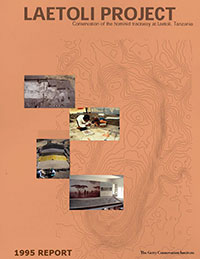
Getty Conservation Institute
1996
Download PDF Low resolution (33.3MB)
Download PDF High resolution (42.4MB)
The Pliocene site of Laetoli, which preserves both hominid and faunal tracks, has immense scientific value, particularly for understanding human evolution. The trackway at Site G, fortuitously preserved within layers of volcanic tuff, offers unique evidence of bipedalism in hominids from 3.6 million years ago. Excavated by Mary Leakey in 1978–79, the trackway was documented and then reburied underneath a mantle of soil and lava boulders. Soon after, acacia trees and other vegetation took root in the burial fill, raising concerns about the survival of the trackway. In 1993 this concern led to a joint Getty Conservation Institute–Government of Tanzania project to conserve the trackway.
This report details the 1995 Laetoli field campaign that initiated the third phase of activity in the Hominid Trackway at Laetoli project and the first major conservation field season on the southern 10m of the trackway. The report covers all activities, including re-excavation of the trackway, condition recording, treatment of the roots of acacia trees, making molds and casts of the original 1978–79 casts, undertaking site mapping, photography and photogrammetry, implementing site stabilization measures, and consulting with the local Maasai community. The report also includes preliminary reports of the scientific re-study done under separate agreement with the Department of Antiquities.
How to Cite this Work
Getty Conservation Institute. 1996. Laetoli Project: Conservation of the Hominid Trackway Site at Laetoli, Tanzania: Report on the 1995 Field Season (July 3- September 2, 1995). Los Angeles: Getty Conservation Institute. http://hdl.handle.net/10020/gci_pubs/laetoli_field_report_1995
|
|||||||||||||||||||||||||||||||||||||||||